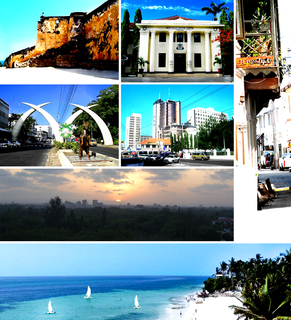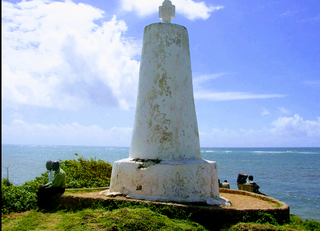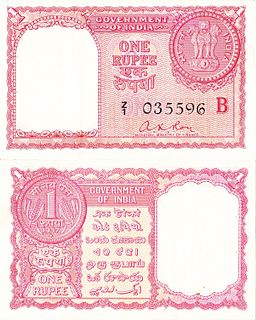Related Research Articles

Mombasa is a coastal city in southeastern Kenya along the Indian Ocean. The city is known as the white and blue city in Kenya. It is the country's oldest and second-largest city, with a population of about 1,208,333 people according to the 2019 census. Its metropolitan region is the second-largest in the country, and has a population of 3,528,940 people.

Rupee is the common name for the currencies of India, Indonesia, the Maldives, Mauritius, Nepal, Pakistan, Seychelles, and Sri Lanka, and of former currencies of Afghanistan, Bahrain, Kuwait, Oman, the UAE, British East Africa, Burma, German East Africa, and Tibet. In Indonesia and the Maldives the unit of currency is known as rupiah and rufiyaa respectively.

The Indian rupee is the official currency of India. The rupee is subdivided into 100 paise, though as of 2019, coins of denomination of 1 rupee is the lowest value in use. The issuance of the currency is controlled by the Reserve Bank of India. The Reserve Bank manages currency in India and derives its role in currency management on the basis of the Reserve Bank of India Act, 1934.
The Uganda Railway was a metre-gauge railway system and former British state-owned railway company. The line linked the interiors of Uganda and Kenya with the Indian Ocean port of Mombasa in Kenya. After a series of mergers and splits, the line is now in the hands of the Kenya Railways Corporation and the Uganda Railways Corporation.

Fort Jesus is a fort located on Mombasa Island. Designed by Italian Giovanni Battista Cairati, it was built between 1593 and 1596 by order of King Felipe II of Castille, who also reigned as King Filipe I of Portugal and the Algarves, to guard the Old Port of Mombasa. Fort Jesus was the only fort maintained by the Portuguese on the Swahili coast, and is recognised as a testament to the first successful attempt by a Western power to establish influence over the Indian Ocean trade.

This is a survey of the postage stamps and postal history of German East Africa.
This is a survey of the postage stamps and postal history of British East Africa.

Malindi is a town on Malindi Bay at the mouth of the Sabaki River, lying on the Indian Ocean coast of Kenya. It is 120 kilometres northeast of Mombasa. The population of Malindi was 119,859 as of the 2019 census. It is the largest urban centre in Kilifi County.

The Gulf rupee was the official currency used in the British protectorates of the Arabian Peninsula that are around the Persian Gulf between 1959 and 1966. These areas today form the countries of Kuwait, Bahrain, Qatar, Oman, and the United Arab Emirates. It was issued by the Government of India and the Reserve Bank of India and was equivalent to the Indian rupee.

East Africa Protectorate was an area in the African Great Lakes occupying roughly the same terrain as present-day Kenya from the Indian Ocean inland to the border with Uganda in the west. Controlled by Britain in the late 19th century, it grew out of British commercial interests in the area in the 1880s and remained a protectorate until 1920 when it became the Colony of Kenya, save for an independent 16-kilometre-wide (10 mi) coastal strip that became the Kenya Protectorate.

The East African shilling was the currency issued for use in British controlled areas in East Africa from 1921 until 1969. It was produced by the East African Currency Board. It is also the proposed name for a common currency that the East African Community plans to introduce.

The history of the Rupee traces back to ancient Indian subcontinent. The mention of rūpya by Panini is seemingly the earliest reference in a text about coins. The term in Indian subcontinent was used for referring to a coin.
The rupee was the currency of Britain's East African colonies and protectorates between 1906 and 1920. It was divided into 100 cents.

Indians in Kenya are citizens and residents of Kenya with ancestral roots in the Indian subcontinent. Most are found in the major urban areas of Nairobi and Mombasa, with others living in rural areas.

The Colony and Protectorate of Kenya, commonly known as British Kenya, was part of the British Empire in Africa. It was established when the former East Africa Protectorate was transformed into a British Crown colony in 1920. Technically, the 'Colony of Kenya' referred to the interior lands, while a 16 km (10 mi) coastal strip was the 'Protectorate of Kenya', but the two were controlled as a single administrative unit. The colony came to an end in 1963 when a black majority government was elected for the first time and eventually declared independence as Kenya.
British involvement in the Middle East began with the Aden Settlement in 1839. The British East India Company established an anti-piracy station in Aden to protect British shipping that was sailing to and from India. The Trucial States were similarly brought into the British Empire as a base for suppressing sea piracy in the Persian Gulf. Involvement in the region expanded to Egypt because of the Suez canal, as well as to Bahrain, Qatar, and Muscat. Kuwait was added in 1899 because of fears about the proposed Berlin-Baghdad Railway. There was a growing fear in the United Kingdom that Germany was a rising power, and there was concern about the implications of access to the Persian Gulf that would arise from the Berlin-Baghdad Railway. After the First World War the British influence in the Middle East reached its fullest extent with the inclusion of Palestine, Transjordan and Iraq.
Mackinnon Road is a town in Kwale County, Kenya, with a population of around 8000 in 1999, located between Mombasa and Voi. Just a few kilometers from Taru.
British East Africa 1896 is a Battle Honour awarded to the 24th (Baluchistan) Regiment of Bombay Infantry; an infantry battalion of the British Indian Army, which participated in the 1896 expedition to British East Africa to suppress a local rebellion.

British trading posts in India were first established by the East India Company (EIC) early in the seventeenth century, which quickly evolved into larger colonies covering a significant part of the subcontinent. Early settlements or factories included Masulipatnam (1611) and Madras (1640) in the south, Surat (1612) in the west, and modern-day Kolkata (1698–99) in the east. These colonies gave rise to Madras Presidency, Bombay Presidency, and Bengal Presidency, and each Presidency had a separate coinage and monetary system. In time, the EIC adopted a unified system of coinage throughout all British possessions in India and the older Presidency system was discontinued. After the Indian Rebellion of 1857, control of EIC territories passed to the British Crown. Coinage issued after 1857 were under the authority of the monarch as India became part of the British Empire. With the Royal Titles Act 1876, Victoria took the title "Empress of India", so in 1877 coin inscriptions changed from Victoria Queen to Victoria Empress. There was a transition period after India gained independence on 15 August 1947, and the first set of republic India coins were issued in 1950.
The following is a timeline of the history of the city of Mombasa, Coast Province, Kenya.
References
- ↑ "The Mombasa Rupee of British East Africa". Mintage World. 2 December 2016. Retrieved 10 May 2018.